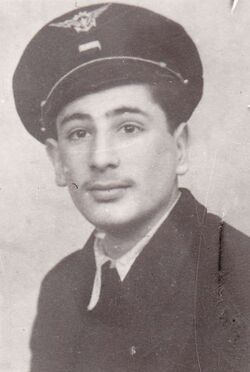Adolphe Zdroui (M / France, 1930), Holocaust survivor
Adolphe "André" Zdroui (M / France, 1930), Holocaust survivor
- KEYWORDS : <Hidden Children>
Biography (USHMM)
Adolphe Zdroui, who now goes by André, thinks this photograph was taken in 1947 when he was sent by the World Jewish Congress to Great Britain as an orphan.
André was born on December 1, 1930, at the Hôpital Rothschild in Paris (12tharrondissement). His father was from Ukraine (born in February 1902) and his mother from Warsaw (born July 23, 1903). Both of them immigrated to France in the 1920s (his father in 1921 and his mother in 1929), and they married in 1929. André’s parents spoke several languages: Russian, Polish, German, Yiddish, and French.
When the war broke out, André’s father joined the Foreign Legion since he was stateless and held a Nansen passport. He was then requisitioned to work for an armament factory. In May 1940, because of the German occupation, the factory moved from Issy-les-Moulineaux to Auvergne before shutting down after the armistice was signed. André’s father was de facto in the free zone of France and tried to have his wife and son join him. But in August 1940, André’s father was sent back to the occupied zone by two French Gendarmes. He went back to his apartment located at 28 rue de la Fontaine au Roi in the 11tharrondissement of Paris and was arrested on August 20, 1941. He was sent to Drancy where he remained until the end of April 1942. Then, he was transferred to Compiègne and deported from there to Auschwitz on June 5, 1942 (Convoy 2).
André’s mother fell sick after her husband’s deportation, and André had to go from one children’s home to another for several short periods every time his mother was unable to take care of him.
On July 16, 1942, during the big roundup in Paris, André’s mother was warned by the concierge. When two French policemen knocked on the door of the apartment, she put her hand over André’s mouth to prevent him from shouting. Fortunately, the policemen did not break down the door and left. The concierge told André and his mother to leave right away. They packed and left the apartment to find refuge at André’s mother’s younger sister’s small house in Villepinte. They stayed there for several weeks, sharing the house with 15 other members of the maternal family in difficult close quarters.
Without telling his mother, André decided to go back to their apartment in Paris to get some clothes. He was arrested by two policemen on the metro, but managed to escape.
André’s mother’s health was deteriorating and she had to go to the Hôpital Tenon. André was then sent to the Rothschild Orphanage in October 1942. He could not stand being locked in and decided to escape from the orphanage in January 1943, jumping out of a window that he had previously broken. He went to stay with an aunt in the 20tharrondissement of Paris, but she could not support him and André had to live on the street for two months until someone found him and took him to a hospital because he was starving to death.
After the hospital, André was sent to the convalescent home Maurice Viollette in Dreux where he stayed for 18 months. There, the director who was a fervent Christian protected all of the children. To her, there were no Jewish children or Catholic children, but only sick children.
André’s mother was at the Hôpital Saint-Louis in Paris. While in any hospital, she was always protected by doctors against possible arrest.
André does not know exactly how, but he and his mother were able to write to each other throughout the war.
On October 5, 1944, André’s mother went to Dreux to bring him back home. They were then able to go back to their apartment in Paris that had been completely emptied.
André remembers the immediate postwar period as a very difficult one. He and his mother kept hoping that his father would come back. They received some help from the Jewish organization Comité Juif d'Action Sociale et de Reconstruction (COJASOR) and the Oeuvre de Secours aux Enfants (OSE). His mother was hospitalized several times and André had to go to different children’s homes. He went to the Comité des oeuvres sociales de la résistance (COSOR) in Orly where he stayed several months and met Raymond Zaks. He also went to a harchara in order to be sent later on to Palestine, but André wanted to remain in France and moved to the Château de Corbeville in Orsay (Essone) that was under the umbrella of OSE.
Because he no longer wanted to be sent from one home to another, André told his mother that he would stay at home by himself every time she went to the hospital. Although he was only 15, she agreed and taught him to cook, iron, and sew in order to be independent. André went to the Télégraphie Sans Fil (TSF) school in 1946, but he had to work to make a living. He then went to the Obshchestvo Remeslennogo Truda (ORT) school, where he learned to be a confectioner’s technician and to make clothes with a sewing machine.
André worked many jobs to support himself and his mother. Because he could not remain inside an office all day, he worked for a Swiss company selling electrical measuring instruments to power plants in his sales territory. He later became an engineer at the same company. André is a self-made man. In 1954, he married and has two children (a son and a daughter). He now has one granddaughter and two grandsons.
